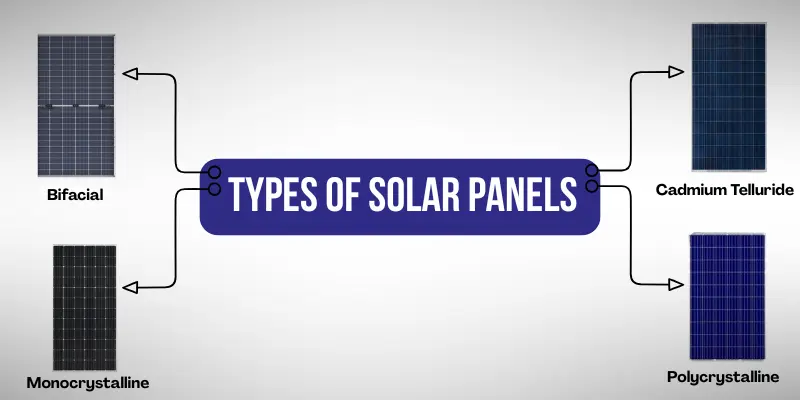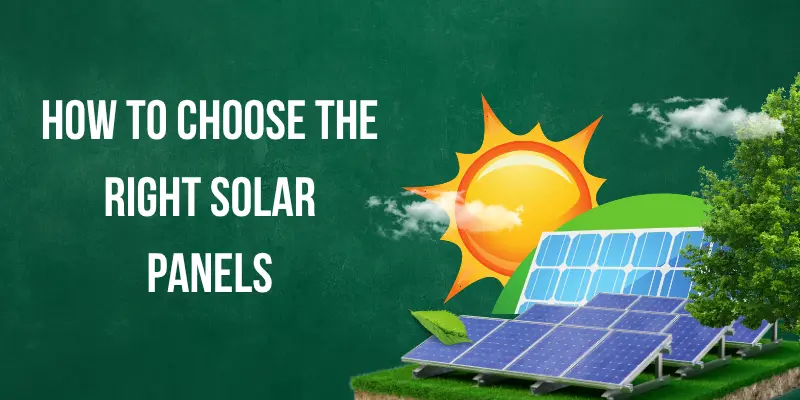Types of Solar Panels: Everything You Need to Know Before You Buy
Published: 4 Aug 2025
Solar energy is transforming the way we power the world. It’s clean, renewable, and can help you save money on your electric bill. But before you install a solar system, you must select the appropriate type of solar panel. This decision influences the performance, cost, and lifespan of your solar system.
In this article, we’ll explain what a solar panel is, go over the various types of solar panels, help you choose the best one, and highlight common mistakes people make when purchasing solar panels. Let’s get started.
What is a Solar Panel?
A solar panel is a device that converts sunlight to electricity. It utilizes small units known as solar cells, which are typically made of silicon. These cells convert solar energy into direct current (DC) electricity. An inverter then converts that direct current (DC) into alternating current (AC) power for your home or office.(If you want to learn more, check out our guide on the different types of inverters and how they work.)
Solar panels are installed on rooftops, open spaces, and even vehicles. They are an essential component of any solar energy system and come in various configurations, each with its own set of advantages.

Types of Solar Panels
Solar panels come in different types, each designed to fit specific energy needs, budgets, and installation areas. By understanding the types of solar panels available, you can choose the best option for your home, business, or any project.
Let’s explore the main types below:
1. Monocrystalline Solar Panels
Monocrystalline panels are made of a single pure silicon crystal. They have the highest efficiency, typically ranging from 18% to 22%. These panels work well in small spaces because they produce more power in a smaller area. They are also durable and long-lasting, but more expensive than other types of materials.
2. Polycrystalline Solar Panels
Polycrystalline panels are created by melting several silicon fragments together. They are slightly less efficient (15%–17%) but more affordable. These panels are an excellent option if you have a larger roof and want to save money. Their performance is slightly lower, particularly in low-light or high-temperature environments.
3. Thin-Film Solar Panels
Thin-film panels are made from materials such as cadmium telluride and amorphous silicon. They are adaptable, lightweight, and simple to install on surfaces such as RVs or curved roofs. However, their efficiency is lower (between 10% and 13%), and they may not last as long as silicon panels. They are ideal for large-scale or specialized projects.
4. Passivated Emitter and Rear Cell (PERC) Panels
PERC panels are an improved version of monocrystalline or polycrystalline panels. They include an additional layer that reflects sunlight into the cell, increasing efficiency. These panels perform better in low light and at high temperatures. They are an excellent choice if you require high performance in harsh weather conditions
5. Bifacial Solar Panels
Bifacial panels can collect sunlight from both the front and back sides. This helps generate more electricity, primarily when sunlight reflects off surfaces such as white roofs or the ground. They are usually made of monocrystalline cells and are highly efficient. They are ideal for commercial or large-scale installations.
6. Concentrated Photovoltaic (CPV) Panels
CPV panels use lenses or mirrors to direct sunlight to highly efficient solar cells. They can achieve more than 40% efficiency, but only work in direct sunlight. These panels require tracking systems and are typically used in large solar farms, not homes. They are expensive and uncommon for everyday use.
7. Concentrated Photovoltaic (CPV) Panels
Amorphous solar panels are a type of thin-film panel made from non-crystalline silicon. They are lightweight, flexible, and cost-effective. However, they offer lower efficiency compared to traditional silicon panels. These panels are commonly used in small devices like calculators, portable solar chargers, and wearable tech.
8. Cadmium Telluride (CdTe) Solar Panels
CdTe panels are the most popular type of thin-film solar panel. They are inexpensive to produce and have a lower carbon footprint. Their efficiency is moderate but improving with new technology. These panels are best suited for large utility-scale solar farms.
9. Copper Indium Gallium Selenide (CIGS) Panels
CIGS panels are another type of thin-film panel that is known for its higher efficiency than other thin films. They are flexible and can be installed on curved surfaces. These panels perform well under various lighting conditions. They are used in specialized applications where flexibility is critical.
10. Organic Photovoltaic Cells (OPV)
OPV panels generate electricity through the use of organic materials (such as plastics or carbon-based compounds). They are extremely lightweight and can be printed on flexible surfaces. Their efficiency remains low, and they have a shorter lifespan, but they are being tested for future use. OPV panels show promise for wearables and low-power devices.

How to Choose the Right Solar Panel
Choosing the right panel depends on your needs, space, and budget. Here are a few tips to help you make the best decision:
1. Check Your Roof Space
If your roof is small, choose high-efficiency monocrystalline panels. If space is not an issue, polycrystalline panels are a cost-effective option.c
2. Set Your Budget
Polycrystalline or thin-film panels can be effective on a limited budget. Remember, cheaper panels may provide less power, so you may need more of them.
3. Consider the Climate
Thin-film panels perform better in hotter climates. If you live in an area with limited sunlight, monocrystalline crystals are ideal because they perform well even in low light conditions.
4. Think About Aesthetics
Some people prefer sleek black panels. If looks matter, monocrystalline panels usually look better on rooftops.
5. Ask for Warranty
Always check your warranty. Good panels come with at least a 20-25 year warranty. That shows the manufacturer’s confidence in its product.
Common Mistakes to Avoid When Buying a Solar Panel
Buying solar panels is a big investment, so avoid these common errors:
1. Choosing Based on Price Alone
Going cheap may appear wise, but low-cost panels frequently have poor efficiency and shorter lifespans. Maintain a balance between price and quality.
2. Not Checking Efficiency Ratings
Efficiency tells you how much sunlight turns into electricity. Low-efficiency panels mean more space and more panels needed.
3. Ignoring Installation Costs
Some panels may be cheap but expensive to install. Always ask for the total cost, including equipment, labor, and permits.
4. Not Thinking Long-Term
Solar panels last for decades. Don’t just think about today’s savings—choose something durable that will perform well for 20+ years.
5. Skipping Professional Advice
Always talk to a professional before buying. They can guide you based on your roof, budget, and energy needs.
Conclusion
Solar panels are an excellent way to harness the sun’s energy for home or business purposes. Whether you choose monocrystalline, polycrystalline, or thin-film panels, the key is to match them to your needs and budget.
Always do your research, compare options, and don’t rush into the cheapest deal. With the right decision, you can enjoy clean energy, lower your bills, and help create a greener future.
Now it’s your turn: which solar panel best fits your roof and budget? Let the sun work for you!
Frequently Asked Questions [FAQs]
Have questions about solar panels? Here are some of the most frequently asked questions to help you better understand the topic:
There are several types of solar panels, each designed for different needs and situations. Here are the main types of solar panels:
- Monocrystalline Solar Panels (Mono-SI)
- Polycrystalline Solar Panels (Poly-SI)
- Thin-Film Solar Panels
- Passivated Emitter and Rear Cell (PERC) Panels
- Bifacial Solar Panels
- Concentrated Photovoltaic (CPV) Panels
- Amorphous Silicon Solar Panels (a-Si)
- Cadmium Telluride (CdTe) Solar Panels
- Copper Indium Gallium Selenide (CIGS) Panels
- Organic Photovoltaic Cells (OPV)
Monocrystalline panels are usually the best choice for home use. They offer high efficiency, long lifespan, and a sleek look. If you have a limited roof area, they’ll give you more power in less space
Thin-film and polycrystalline panels are generally the most budget-friendly. However, you may need more of them to produce the same power as high-efficiency panels.
The best type of solar panel depends on your needs, space, and budget — but overall, Monocrystalline solar panels are considered the best for most users.
Yes, all standard solar panels are designed to withstand rain and outdoor conditions. To avoid water damage or leaks, ensure that they are professionally installed.

- Be Respectful
- Stay Relevant
- Stay Positive
- True Feedback
- Encourage Discussion
- Avoid Spamming
- No Fake News
- Don't Copy-Paste
- No Personal Attacks

- Be Respectful
- Stay Relevant
- Stay Positive
- True Feedback
- Encourage Discussion
- Avoid Spamming
- No Fake News
- Don't Copy-Paste
- No Personal Attacks





